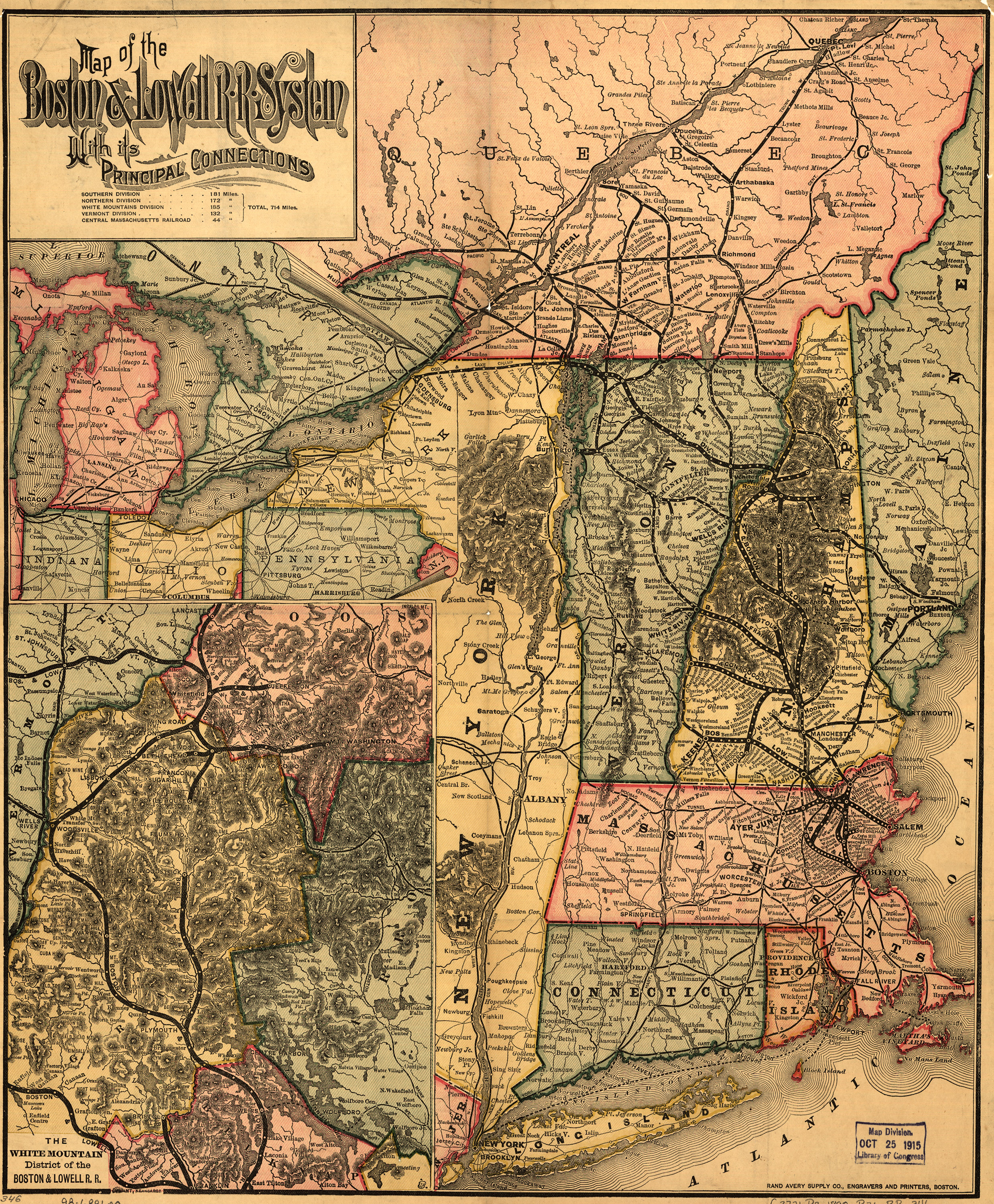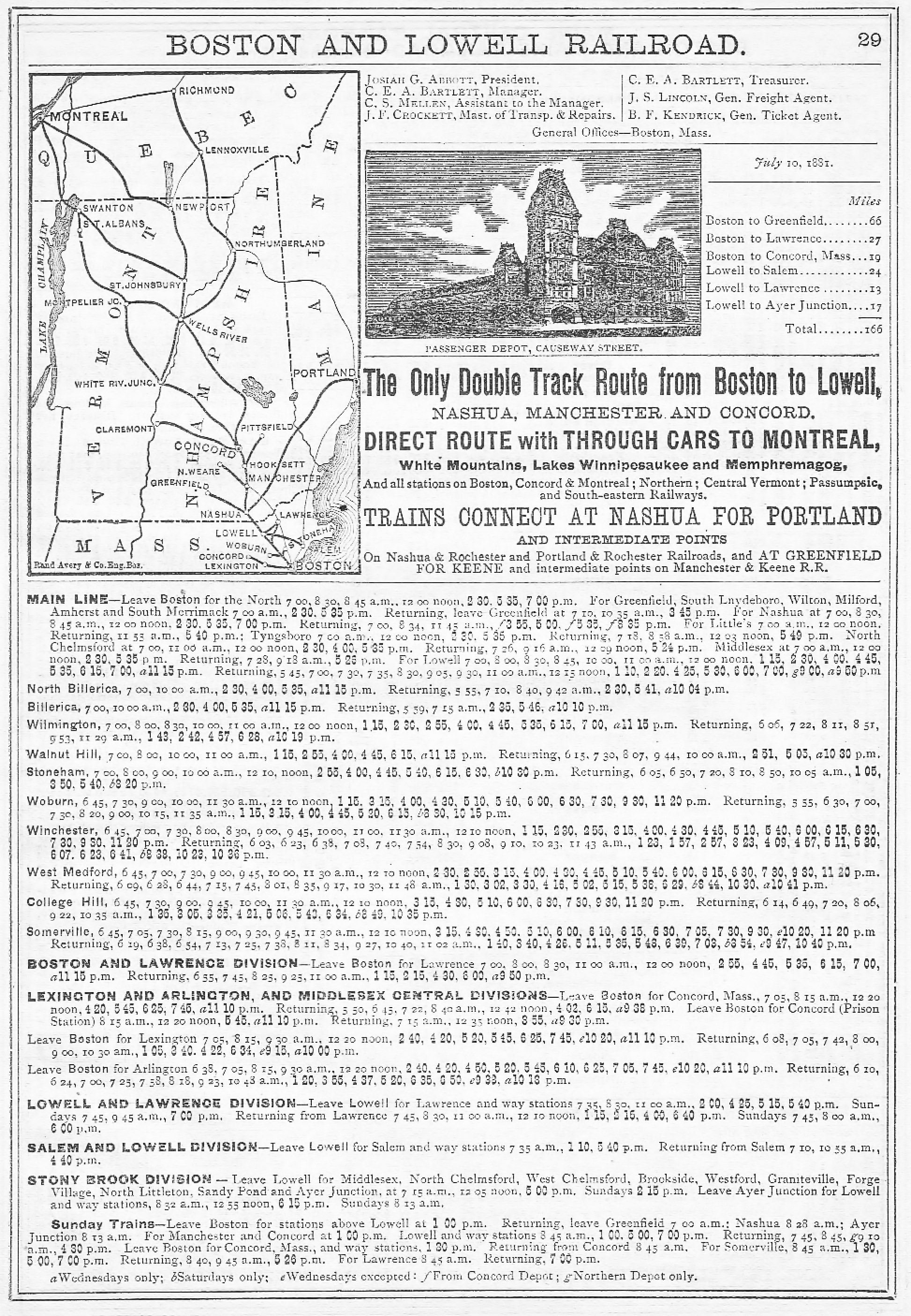Boston & Lowell Railroad: Map, Timetable, History
Published: February 11, 2025
By: Adam Burns
The Boston & Lowell Railroad (B&L) was the Boston & Maine's largest before ultimately being leased by the latter on April 1, 1887. Consequently, the B&L became part of the Boston & Maine Railroad's Southern Division, maintaining its status as a relatively active corridor over the years. Established in the early 19th century, it was one of the pioneering railroads in the nation when formed in the mid-1830s.
From its inception, the railroad facilitated a diverse array of freight - especially when New England enjoyed a strong manufacturing base - and enjoyed a robust passenger business. It expanded its reach with to Keene, New Hampshire, via Milford and Nashua, while additional branches extended to Salem, Concord, and Ayer Junction.
At its peak the system operated a total of 714 miles via five different divisions and served northern New Hampshire, parts of Vermont, and even provided through service to Montreal. Presently, what remains of the B&L is operated by Pan Am Railways/CSX.
System Map (Circa 1887)
Founding and Early Development
The Boston & Lowell was formed at a time when the United States was on the cusp of the Industrial Revolution. The impetus behind its establishment was, in large part, the rapid industrialization occurring in Lowell, Massachusetts.
Lowell had become a burgeoning center for textile manufacturing, and there was a pressing need to efficiently transport raw materials to the mills and then move finished products to markets.
The B&L was officially chartered on June 5, 1830 and by 1835 had linked Boston to Lowell with the inaugural run occurring on May 27th that year.
Notable figures such as Patrick Tracy Jackson, George Washington Whistler, and James Baldwin were all in attendance during the railroad's opening.
The original route ran approximately 26 miles from Boston to Lowell, intending to create a rapid connection between Boston's port facilities and Lowell’s manufacturing hub.
The task of surveying the route and overseeing the construction fell to Loammi Baldwin Jr., a prominent civil engineer. Significantly, this project was among the first to fully embrace the technological innovation of the steam locomotive, marking a shift from traditional horse-drawn railways.
Unfortunately, the B&L experienced an immediate problem; during a time when the industry was still in its infancy no one knew the correct way to lay a railroad or the proper materials to use in securing rail to a support base. The prevailing theory was solid rock was the most ideal.
However, the granite sleepers (ties) proved extremely inflexible, causing considerable jarring to the locomotives and carriages. Consequently, extensive overnight repairs were often required to prepare the two locomotives available for next-day operations.
In contrast, the less affluent Boston & Worcester Railroad opted for modern wooden ties instead of granite, which unexpectedly resulted in superior performance. Consequently, B&L management rebuilt their own main line with such an arrangement and expanded to a double-tracked route.
As anticipated, the B&L experienced substantial freight traffic, driven by Lowell's textile industry, which necessitated the import of raw materials and export of finished products.
In response to growing passenger demand, the company procured an additional locomotive, of the 2-2-0 Planet type, and passenger cars in 1842, instituting six stops along the route. Ultimately, passenger services emerged as nearly as lucrative as freight operations.
The original Boston terminal was strategically situated at the intersection of Causeway Street and Andover Street, positioned at the western edge of what is now North Station. Notably, access to this terminal required traversing the first movable railroad bridge in the United States over the Charles River. Meanwhile, the initial Lowell terminal was located at the corner of Merrimack Street and Dutton Street.
Timetable (1881)
Economic and Industrial Impact
The establishment of the B&L had profound economic implications. It drastically reduced the time and cost of shipping goods between Boston and Lowell, spurring industrial growth in the entire region. Lowell's mills and factories gained a competitive edge due to simplified logistics, enhancing their productivity and output.
This efficiency also facilitated expanded trade routes, allowing goods manufactured in Lowell to reach broader markets. Conversely, raw materials and other necessary supplies could be brought in more swiftly and economically, thus feeding the industrial machine of Lowell.
The B&L played an instrumental role in transforming the region into an industrial powerhouse, accelerating the rise of Massachusetts as a key player in the nation's early industrial landscape.
Moreover, the railroad's success served as a model that inspired the development of other railroads throughout New England and the United States.
B&M Acquisition
The Boston & Lowell maintained success through the 19th and into the early 20th century. As the industrial age progressed, the B&L adapted to compete in an increasingly dense network of rail lines crisscrossing the region. The railroad became part of a larger network of transportation conduits, crucial for sustaining the economy of Massachusetts.
At its peak the railroad operated a total of 714 miles via four different divisions and subsidiary Central Massachusetts Railroad:
- Southern Division - 181 Miles
- Northern Division - 172 Miles
- White Mountains Division - 185 Miles
- Vermont Division - 132 Miles
- Central Massachusetts Railroad - 44 Miles
By the late 19th century, the B&L was absorbed into the larger Boston & Maine when it was formally leased on April 1, 1887.
Over time, the rise of automobile and air travel led to the decline of passenger rail services, and the focus of the rail industry shifted more towards freight. The remnants of the Boston & Lowell line continued to serve freight needs, maintaining its economic relevance in the transporting of industrial materials to and from the region’s aging manufacturing sites.
Legacy
The Boston and Lowell Railroad represents a significant chapter in the narrative of American industrial and technological progress.
It was more than just a mode of transportation; it was a catalyst for change, influencing economic, social, and industrial developments across New England and beyond.
Its legacy lives on in the railways that continue to serve the region, a testament to its lasting impact on the fabric of American industry.
Recent Articles
-
A Florida Christmas Train Ride In Parrish!
Nov 19, 25 01:59 PM
While the museum operates excursions throughout much of the year, its most beloved event arrives with twinkling lights and cooler breezes: the North Pole Express, a holiday train ride that’s become a… -
A Connecticut Christmas Train Ride In Essex!
Nov 19, 25 01:46 PM
While spring through fall bring daily excursions and seasonal special events at the Essex Steam Train, it’s the North Pole Express—its signature holiday journey—that has become a treasured tradition f… -
A Colorado Christmas Train Ride In Georgetown!
Nov 19, 25 01:31 PM
The Georgetown Loop Railroad, a historic narrow-gauge line high in Colorado’s Rockies, firmly belongs in the latter category—especially during its Christmas season rides.





